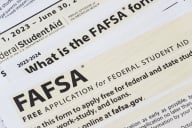You have /5 articles left.
Sign up for a free account or log in.

Students who stop out of college can be encouraged to re-enroll if the institution engages in personalized messaging and other supports.
SDI Productions/E+/Getty Images
Over six million Californians aged 25 to 64 have completed some college but have yet to earn a credential, according to data from the National Student Clearinghouse Research Center. A new report from California Competes identifies four themes in supporting stopped-out students to help them re-enroll and attain degrees in California.
Through interviews, researchers learned institutions have an opportunity to better support students’ degree-completion rates through adaptation to adult learner needs, strategic outreach, removing barriers to enrollment and providing personalized support.
Adapt to today’s students: Flexibility was one of the key themes in the interviews, whether that means providing online courses, accelerated programs, credit for prior learning or competency-based education.
Those with some college, no credential are disproportionately members of underserved populations. Many adult learners are juggling employment and family obligations, making flexible learning modalities and structures key to supporting their work.
Stakeholders should consider:
- Expanding online course offerings in breadth and numbers.
- Adding fully online degree programs.
- Restructuring academic calendars to create shorter terms with additional entry and exit points.
Conduct strategic outreach: Many students who stopped out said they did not receive communication from their institution after leaving. Some remembered receiving an impersonal email that did not address their circumstances.
Staff can, therefore, provide personalized outreach to stopped-out students to talk through barriers to completion, steps to re-enrollment and available resources. When staff reach out, they should help students establish a timeline for when they might return. If a student is unsure if they will return, staff can follow up in six months to see if circumstances have changed.
Inclusive marketing materials and language can benefit this work. Marketing should appeal less to the traditional college experience and more to the services and resources the institution has to support learners with competing priorities (childcare, course flexibility, job placement, etc.). Communication should also be framed positively, not addressing the student as though they’ve failed but instead reassuring them that the institution wants to help them achieve their goals.
Students may also need help in demystifying academic policies that pushed them to stop out, such as academic probation. A majority of the study participants were placed on academic probation, which prompted them to stop out. Few of these students received follow-up after the initial notification, leaving them in the dark about resources and opportunities available to them.
Staff can reframe academic probation to make the process less intimating and involve faculty members to provide early intervention before students get to probation. Advisers can also support this work by providing personal outreach to students on academic notice, listing options for them beyond stopping out.
Remove barriers to enrollment: Once a student decides to return to college, it’s imperative that there are few barriers to entry.
One common concern among participants was getting priority registration to enroll in the necessary courses alongside their peers. Institutions should consider reinstating priority registration status to promote timely degree completion.
Colleges and universities should also review their “catalog rights” policies, if applicable, which apply to a student’s degree progression. These policies can hinder students’ time to degree if they have to retake general education or new degree requirements based on a new academic catalog. Credit for prior learning can also accelerate degree progression.
Other barriers to re-enrollment include:
- Failing grades
- Application requirements and fees
- Outstanding institutional debt
Institutions can implement grade forgiveness and academic renewal policies or provide advising on how to raise their GPA. Decreasing fees and forgiving debt can help near completers return to college without adding additional challenges.
Stopped-out students may also have lost their financial aid based on their circumstances (part-time enrollment, academic probation, eligibility changes). Colleges and universities can step in to provide tuition assistance, book vouchers, course waivers or one-time grants or explore employer tuition benefits to cover the student’s costs.
Supporting Stopouts
The University of Miami’s ’Canes Complete is one example of institutional efforts to support stopped-out students.
Staff reach out to individual students three times a year, offering financial aid and personalized support to create an expedited path to graduation. Since launching in 2012, the initiative has helped 169 students graduate and improved the institution’s six-year graduation rate around 1.5 percentage points each year.
Provide ongoing support: Beyond enrollment, returning students need assistance persisting and graduating. Some possible solutions include:
- A comebacker orientation. Some students experienced anxiety returning to their institution, particularly if significant time had passed since their time in higher education. An orientation can introduce students to their peers, teach them about campus resources, cover new technology and help set the stage for their experience in the institution.
- Adult-focused advising. Colleges should designate one adviser for comebackers or provide training specific to students who had stopped out and returned.
- Online resources. Most adult learners have other priorities beyond their education, so creating asynchronous resources is critical. An online portal or chat can give students a one-stop shop for help at any time.
- Community of support. Interviewed students expressed the importance of a peer community, either those who shared their life stages or who also stopped out. Colleges can dedicate a physical space for adult learners or online events and tools for connection.
- Academic planning and progress. A majority of adult learners do not want career exploration but need help in establishing their academic progression. Required meetings with advisers can establish a structured academic plan for stopped-out students, or institutions can invest in a course management system that allows them to track their time to degree.
We bet your colleague would like this article, too. Send them this link to subscribe to our weekday newsletter on Student Success.








